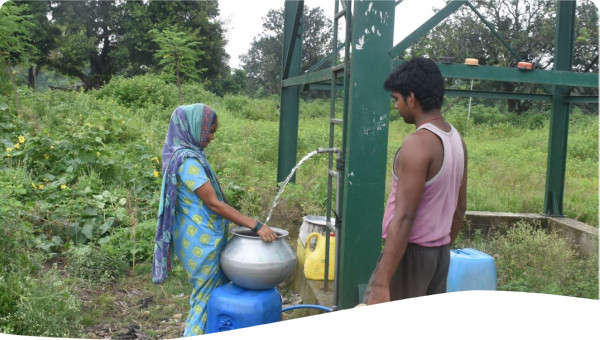Following a decision to decentralise water and wastewater services, many questions regarding the sustainable financing of water and waste services was raised. Recognising that economic and financial conditions are critical to the effectiveness of various tariff and effluent charge reforms, a financial model (ASTEC) was devised. This case demonstrates the value of using economic instruments to support the implementation of IWRM management objectives.
Water for drinking purposes is extracted mainly from ground water sources (more than 83%) and the public water supply provides water to 82.6 % of the population. The ratio between produced and invoiced water represents water losses (28.5%) and technological water (2.3%) (data of year 2001).
Development of public sewer system is not as advanced as the water supply network. 54.3% of the population is connected to sewerage and this has not increased significantly over the last several years. The main users of sewerage are households and provide for 57.5% of the wastewater. The rest is represented by “others” that include industry, commercial and institutional, and administrative bodies. Almost all municipal wastewater entering Waste Water Treatment Plants (WWTP) is treated by mechanical and biological treatment (96.4%). The sewer systems and wastewater treatment plants are behind the overall development of Slovakia’s economy and society. Only 55% of inhabitants are connected into sewer system while there are 205 municipal wastewater treatment plants (as December 2000) that treat municipal (in most cases municipal and industrial) waters.
The management of water resources in Slovakia did not undertake any economic restructuring after political changes in 1989. The Government has had the responsibility to regulate, develop, and provide water services to all users, such as population, industry and agriculture. With respect to infrastructure development, the water and wastewater services were funded directly by the Government.
In 2003, the Slovak Government decided on the decentralization of state owned Water and Waste Water (W&WW) services and a transfer of assets to the municipal level. Decentralization threw up many questions regarding the sustainable financing of water and wastewater services such as monitoring and regulating tariffs. Furthermore, old water and wastewater utilities were turned into municipal water companies with limited assessment of their economic portfolio and performance. This situation became more acute with the adoption of EU legislation in 2004 which tightened rules and regulations regarding permissible levels of pollution and treatment. Only a limited number of existing WWTPs met the EU legislation adding further strain to the financing of water services.
Recognizing that economic and financial conditions are critical to the effectiveness of various tariff and effluent charge reforms, a financial model (ASTEC) was devised. The ASTEC model simulates municipal W&WW accounts. This simulation includes separate accounts for drinking water and wastewater services and both financial and physical accounting for those services. The main objectives include the review, analysis and evaluation of municipal water and wastewater utility tariffs and effluent charges.
In the ASTEC model, water customers can be divided into up to nine groups and distinguished by any dimension considered important by the model user. The ASTEC model helps give decision makers an overview of the financial health of the service through budgetary balances, capital accounts and social accounts which broadens the basis of accounting calculations and sources of economic welfare that are not well reflected by markets. It can also help explain the reason for the financial situation through allocation and distributions of cost to different water and wastewater user groups The model can be used to develop alternative scenarios such as determining the minimum tariffs necessary to cover the costs of service, presenting consequences of tariff and effluent charge levels for water use and wastewater production and effluent output.
The ASTEC model was used and tested in one municipal water company in Slovakia. The model was run for a variety of scenarios such as confirming the current financial condition of the WW utility and exploring the financial, effluent, and other impacts of different tariffs or effluent charges, maintenance programs, and management practices under the "baseline" conditions.
The data was also used to investigate the implications of "sustainable" service levels. In this instance one includes full capital accounts in the ASTEC data entry. The "sustainable" data entries for the study community could be supplemented with cost and financing data for WW utility development plans. This combined data constituted the basis for "expansion/upgrade" scenarios with ASTEC. The development plans included new and improved levels of wastewater treatment. The ASTEC also simulates concurrent changes in water consumption, debt payments, and other physical and financial conditions. The present version of the model requires Excel 2000 or a more developed version of Excel, with Solver installed and Excel enabled to run macros. The user surface of the model is in English, but the Excel itself can be in any language, that is not supposed to affect the proper functioning of the model. In older versions of Excel or obsolete computers running some of the scenarios may require a lot of time or it may not be possible.
Use of economic instruments supports to achieving the IWRM management objectives. Firm and clear regulation of tariffs set by water operators is one of the most important preconditions for the successful cost recovery policy.
In many cases, both regulators and water providers are not fully familiar with economic implications of changes, such as new investments planned to up-grade the technical performance of water utility, proposed increase in pollution charges, and changes in social and economic development of area provided by water. Application of models to simulate different scenarios might help to better decision on future development.
Many water operators do not have transparent systems of bookkeeping and accounting practices.
These systems and practices are essential for developing cost-of-service pricing.
Municipal board representatives are unable to meet their responsibilities, unless they have access to information that clearly shows the financial condition of the operation in enough detail to explain why it is in that condition.
The board has a responsibility to ensure that the municipal water company does not abuse its position as a public monopoly.
 Case studies
Case studies


